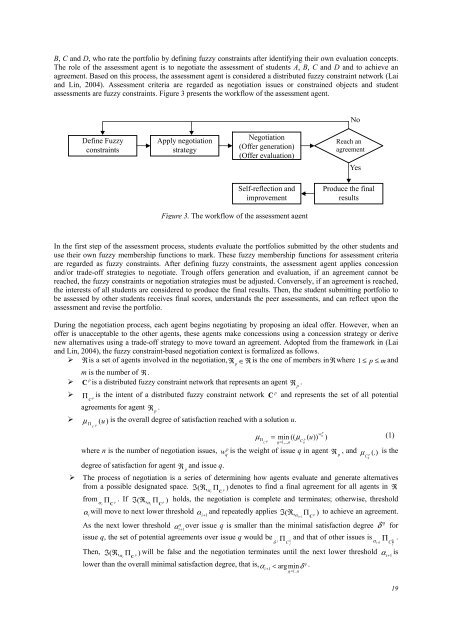July 2006 Volume 9 Number 3 - CiteSeerX
July 2006 Volume 9 Number 3 - CiteSeerX
July 2006 Volume 9 Number 3 - CiteSeerX
Create successful ePaper yourself
Turn your PDF publications into a flip-book with our unique Google optimized e-Paper software.
B, C and D, who rate the portfolio by defining fuzzy constraints after identifying their own evaluation concepts.<br />
The role of the assessment agent is to negotiate the assessment of students A, B, C and D and to achieve an<br />
agreement. Based on this process, the assessment agent is considered a distributed fuzzy constraint network (Lai<br />
and Lin, 2004). Assessment criteria are regarded as negotiation issues or constrained objects and student<br />
assessments are fuzzy constraints. Figure 3 presents the workflow of the assessment agent.<br />
Define Fuzzy<br />
constraints<br />
In the first step of the assessment process, students evaluate the portfolios submitted by the other students and<br />
use their own fuzzy membership functions to mark. These fuzzy membership functions for assessment criteria<br />
are regarded as fuzzy constraints. After defining fuzzy constraints, the assessment agent applies concession<br />
and/or trade-off strategies to negotiate. Trough offers generation and evaluation, if an agreement cannot be<br />
reached, the fuzzy constraints or negotiation strategies must be adjusted. Conversely, if an agreement is reached,<br />
the interests of all students are considered to produce the final results. Then, the student submitting portfolio to<br />
be assessed by other students receives final scores, understands the peer assessments, and can reflect upon the<br />
assessment and revise the portfolio.<br />
During the negotiation process, each agent begins negotiating by proposing an ideal offer. However, when an<br />
offer is unacceptable to the other agents, these agents make concessions using a concession strategy or derive<br />
new alternatives using a trade-off strategy to move toward an agreement. Adopted from the framework in (Lai<br />
and Lin, 2004), the fuzzy constraint-based negotiation context is formalized as follows.<br />
ℜ is a set of agents involved in the negotiation, ℜ p ∈ℜ<br />
is the one of members inℜwhere 1 ≤ p ≤ m and<br />
m is the number of ℜ .<br />
p<br />
C is a distributed fuzzy constraint network that represents an agent ℜ . p<br />
p<br />
Π is the intent of a distributed fuzzy constraint network p<br />
C and represents the set of all potential<br />
C<br />
agreements for agent ℜ . p<br />
μ (u ) is the overall degree of satisfaction reached with a solution u.<br />
Π<br />
p<br />
C<br />
Apply negotiation<br />
strategy<br />
Negotiation<br />
(Offer generation)<br />
(Offer evaluation)<br />
Self-reflection and<br />
improvement<br />
Figure 3. The workflow of the assessment agent<br />
p<br />
wq<br />
μΠ<br />
= min (( μ p ( u))<br />
)<br />
(1)<br />
C<br />
p q=<br />
1,..,<br />
n Cq<br />
p<br />
where n is the number of negotiation issues, w is the weight of issue q in agent q<br />
ℜ , and p μ p (.) is the<br />
Cq<br />
degree of satisfaction for agent ℜ and issue q.<br />
p<br />
The process of negotiation is a series of determining how agents evaluate and generate alternatives<br />
from a possible designated space. ( ,<br />
p )<br />
i C Π ℜ ℑ denotes to find a final agreement for all agents in ℜ<br />
α<br />
from p<br />
i C Π . If α ( ,<br />
p )<br />
i C Π ℜ ℑ holds, the negotiation is complete and terminates; otherwise, threshold<br />
α<br />
α will move to next lower threshold i<br />
α and repeatedly applies i+<br />
1<br />
( ,<br />
p )<br />
i 1 C Π ℜ ℑ to achieve an agreement.<br />
α +<br />
As the next lower threshold q<br />
q<br />
α over issue q is smaller than the minimal satisfaction degree δ for<br />
i+ 1<br />
issue q, the set of potential agreements over issue q would be j Π and that of other issues is k k<br />
δ C j<br />
i C j<br />
Π .<br />
α +1<br />
Then, ( ,<br />
p )<br />
i C Π ℜ ℑ will be false and the negotiation terminates until the next lower threshold α α is i+<br />
1<br />
lower than the overall minimal satisfaction degree, that is,<br />
q<br />
αi<br />
+ 1 arg minδ<br />
q=<br />
1..<br />
n<br />
< .<br />
No<br />
Reach an<br />
agreement<br />
Yes<br />
Produce the final<br />
results<br />
19

















